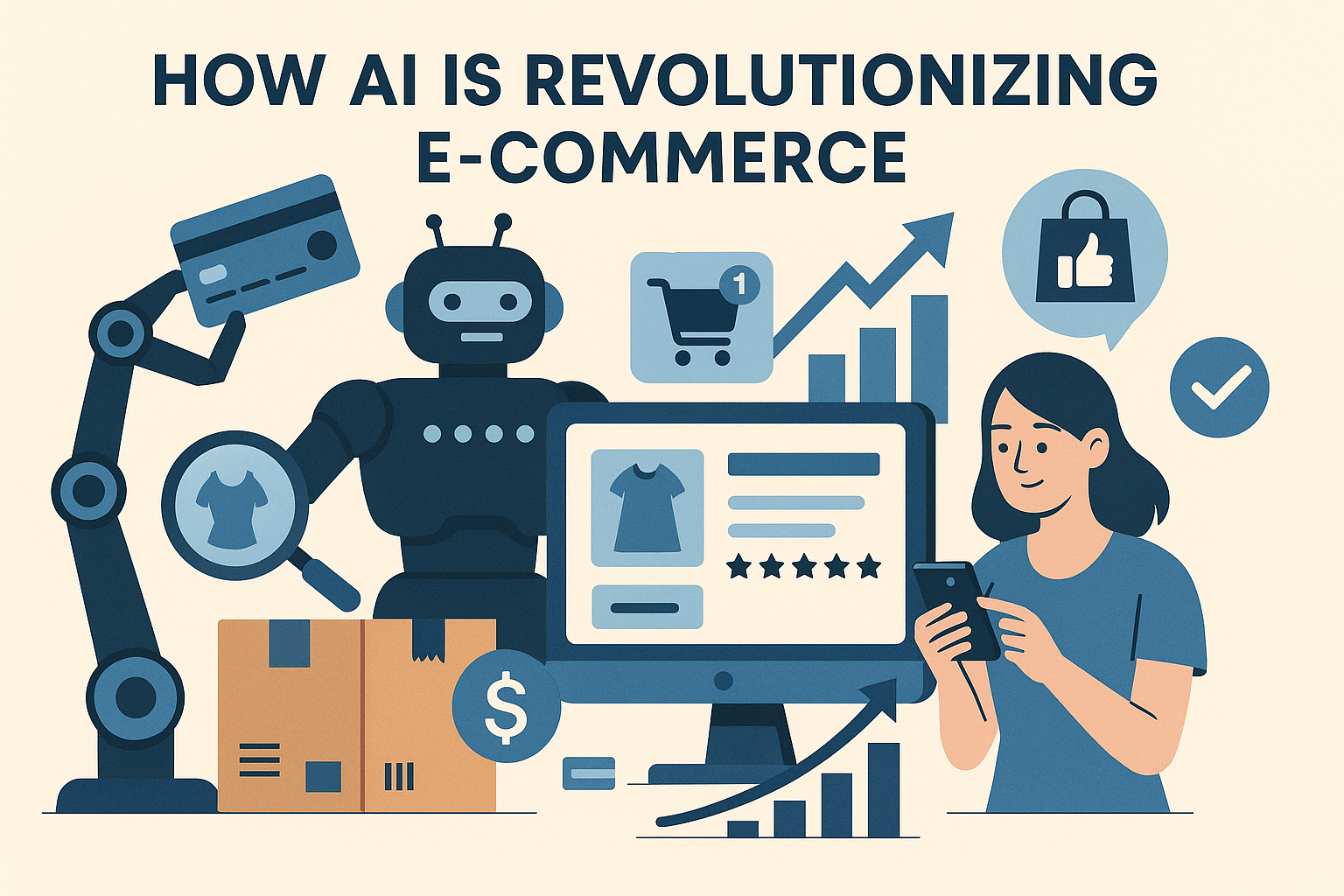The e-commerce industry is in the midst of a dramatic transformation — and Artificial Intelligence (AI) is leading the charge. From personalized shopping experiences to smarter inventory management, AI is empowering online retailers to operate more efficiently, scale faster, and delight customers like never before.
In this article, we’ll explore the many ways AI is revolutionizing e-commerce, with practical examples that show how businesses of all sizes can benefit.
Why AI Matters in E-Commerce
Online retail generates billions of customer interactions, transactions, and preferences daily. Human teams can’t analyze all this data fast enough — but AI can. By leveraging machine learning, natural language processing, and predictive analytics, e-commerce platforms can:
- Personalize customer journeys
- Improve product recommendations
- Detect fraud in real-time
- Optimize logistics and inventory
- Automate marketing and support
Let’s dive into the most powerful ways AI is changing online shopping.
1. Personalized Product Recommendations
AI algorithms analyze user behavior — like browsing history, purchases, clicks, and even time spent on pages — to deliver personalized product suggestions.
Examples:
- Amazon’s “Customers also bought” engine
- Netflix-style recommendations on fashion sites
- Real-time upsells based on items in the cart
Benefits:
- Higher conversion rates
- Increased average order value
- Better customer experience
2. AI-Powered Chatbots and Virtual Assistants
AI-driven chatbots are now capable of handling a wide range of customer queries, from tracking orders to recommending products.
Examples:
- Sephora’s chatbot that suggests makeup based on selfies
- H&M’s virtual stylist that helps pick outfits
- Shopify stores using AI for 24/7 support
Why it matters:
- Reduces customer support costs
- Provides instant assistance at scale
- Improves satisfaction and trust
3. Dynamic Pricing Optimization
AI can adjust product prices in real time based on:
- Competitor pricing
- Customer demand
- Inventory levels
- Time of day or seasonality
Use cases:
- Airlines and hotels adjusting prices minute-by-minute
- E-commerce flash sales triggered by shopping behavior
- Personalized discounts based on customer loyalty
4. Smart Inventory and Demand Forecasting
Machine learning can analyze past sales, market trends, and external factors (like weather or holidays) to predict future demand.
What it helps with:
- Preventing overstock or stockouts
- Optimizing warehouse operations
- Reducing storage costs
Companies like Zara and Walmart use AI to plan inventory more accurately and respond quickly to market trends.
5. Visual Search and Image Recognition
With AI, shoppers can upload an image and find similar products instantly.
Examples:
- Pinterest’s visual search tool
- ASOS and Amazon StyleSnap apps
- IKEA’s photo-based product finder
How it helps:
- Simplifies product discovery
- Enhances mobile shopping experiences
- Converts inspiration into purchases faster
6. Fraud Detection and Risk Management
AI monitors thousands of transactions per second to spot unusual patterns and block suspicious activity.
Features:
- Behavioral biometrics
- Geolocation mismatch detection
- AI-based fraud scoring systems
Results:
- Safer transactions
- Reduced chargebacks
- Greater customer trust
7. Automated Content Creation
AI tools like ChatGPT and Jasper help e-commerce teams write:
- Product descriptions
- SEO-friendly category pages
- Ad copy and emails
Advantages:
- Faster content production
- Consistent tone and branding
- Lower copywriting costs
Pro tip: Combine human editing with AI drafts for the best results.
8. AI-Driven Email and Retargeting Campaigns
Marketing platforms use AI to optimize email timing, subject lines, and content based on individual behavior.
Use cases:
- Abandoned cart recovery
- Post-purchase upselling
- Birthday or loyalty emails
Platforms like Klaviyo, Mailchimp, and ActiveCampaign offer AI-powered segmentation and automation tools.
9. Customer Sentiment Analysis
AI can analyze reviews, feedback, and support tickets to detect customer satisfaction and issues in real time.
Benefits:
- Identify top product complaints
- Improve customer service
- Discover trends in buyer behavior
Tools like MonkeyLearn and Lexalytics turn unstructured data into actionable insights.
10. Voice Commerce Integration
AI voice assistants like Alexa, Siri, and Google Assistant allow users to shop with their voice.
Examples:
- Reordering household items with Amazon Alexa
- Searching for deals via Google Assistant
- Managing shopping lists hands-free
This trend is expected to grow, especially in smart homes and on-the-go shopping.
Final Thoughts: The Future of AI in E-Commerce
AI is no longer a luxury — it’s a necessity for e-commerce brands that want to stay competitive. From enhancing customer experiences to driving operational efficiency, AI provides the tools to scale smartly and sustainably.
As technology evolves, expect to see even more AI innovations in areas like augmented reality (AR), supply chain optimization, and predictive customer service.
By embracing AI now, e-commerce businesses can position themselves not just to survive the future — but to lead it.
